| 
Map of the
Hawaiian Island chain. Midway and Kure are located about 1000 nautical
miles west northwest of Pearl Harbor. All the islands west of
Kauai are coral atolls formed on top of submerged (planated) volcanoes.
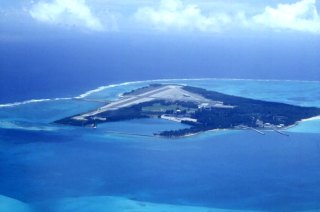
Aerial view of Sand Island at Midway Atoll. This was a gas-and-go
stop for land-based Navy aircraft on most trips to WESTPAC. The
enormous runway here was all constructed after World war II, when Midway
became an importanmt DEW base. In mid-November 1990 I spent an
entire week exploring the islands with a USFWS orinthologist after after
my P-3 suffered a burned deicer boot and awaited repairs.
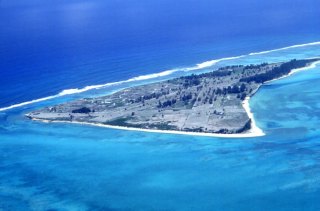
Eastern Island is the other sizable patch of land on Midway Atoll.
It served as our primary air base during the Battle of Midway in early
June 1942, supporting three crossing runways. The island was set
aside as a bird sanctuary in 1970 and no Navy personnel were allowed
on it. Note the Norfolk Pines growing up through the concrete
pavement!
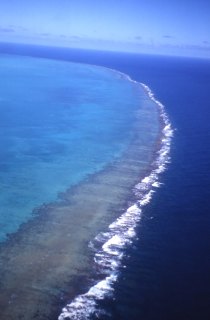
Midway is a spectacular coral atoll built upon a submerged volcano in
the western Hawaiian Island chain. It was discovered in 1859 and
claimed by the United States in 1867. This shows the perimeter
reef, which separates the shallow lagoon (at left) from the open ocean
at right. The reef grew 350 feet vertically as sea level rose
over the past 11,000 years.
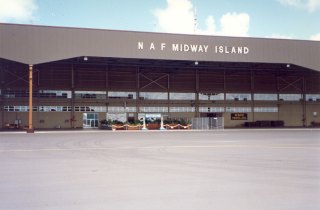
Midway ended its military career as a Naval Air Facilty, without medical
services or dependents. The atoll was the scene of a titanic naval battle
on June 4-5-6, 1942, when the combat radius of piston-engine warplanes
made the island strategically valuable. Located 1300 sea miles west
northwest of Pearl Harbor it served as an importnat resupply base for
our submarines during World War II, saving them 2600 additional miles
on each war patrol. The base was expanded during the late 1950s as a
Distant Early Warning (DEW) base, then mothballed in the late 1970s,
when satellites took over the DEW role. NAF Midway was turned
over to the US Fish & Wildlife Service in 1997.
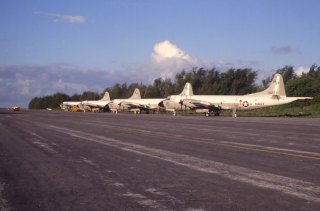
During the late stages of the Cold War VP-31 was NAF Midway’s
biggest “customer”, with most of our trans-Pacific training
flights stopping here to rest and gas up. In August 1990 I snapped
this picture of four Black Knight P-3s parked on the transient ramp.
The aircraft are (closest to farthest): RP-16, RP-00, RP-10 and RP-03.
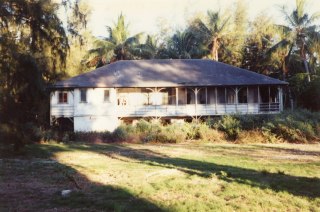
The United States permanently occupied Midway in 1903, during laying
of the first TransPacific cable. This is one of the original structures,
dating from 1906, but subsequently used by Pan American Airlines when
they began using Midway as a stopover on their trans-Pacific flights
in 1936. An old graveyard lies behind this abandoned structrure.
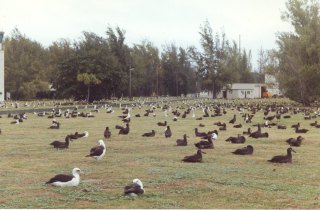
From early October until August of the following year Midway Atoll belongs
to the Laysan Albatross, colloquially termed “Gooney Birds”
by Navy personnel. 90% of Laysan Albatrosses breed here. Returning
adult albatrosses remember where they were hatched years previous and
make their nest in precisely the same spots, even if paved over by concrete
or asphalt! The darker specimens are the immature birds that are
not large enough to fly the thousands of miles needed to survive over
the open sea for 3 to 4 years before returning to nest (that's right,
they don't land for 3 to 4 years!).
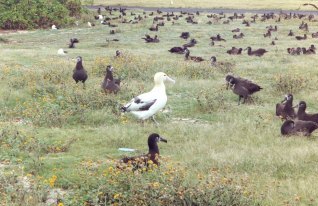
This shows a Stellar's Albatross or “golden goony”, easily
discerned by its golden head. It is a highly endangered species
and comes from islands in the northwest Pacific, where the Japanese
almost hunted it to extinction in search of its plumes. It is
also known as the short-tailed albatross.
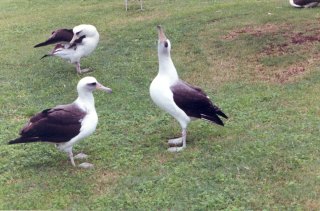
During mating season (October), single albatrosses spend most of their
time trying to find a lifetime mate, going through the ritual shown
here (male on the right, female on the left). After mating the
female lays a single egg. If the egg is lost, the parents return
to the sea until the following year. Mature birds without mates
may spend a good part of the year on the island trying to establish
a pair bond. Once they have a mate, the two select a nest site
before returning to the sea for the rest of the year.
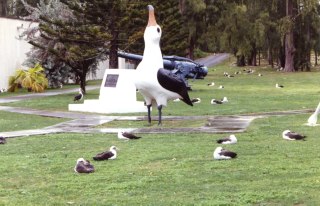
This shows the enormous Gooney Bird statue on Midway’s Sand Island,
next to the World War II memorial with its 5-inch-38 caliber shore battery
rifle. Marine First Lieutenant George H. Cannon was awarded a
posthumous Medal of Honor for dying at his post while returning fire
with this weapon against Japanese warships on December 7, 1941, the
day Pearl Harbor was bombed over 1000 miles away.
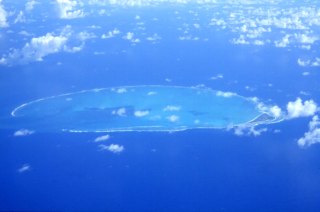
Kure Island is located about 56 miles west northwest of Midway. It is
about 6 miles in diameter and is the northernmost coral atoll in the
world, at 28.25 North Latitude. Until 1992 the Coast Guard maintained
a Loran C station here, with two 520 ft high towers. In those
days the station was resupplied on Thursdays by a Coast Guard C-130
Hercules, which I managed to catch during one of my stays at Midway.
It is the oldest and westernmost exposure of the Hawaiian Islands chain
of volcanoes, which were erupted over two parallel hot spots in the
ocean’s floor as the Pacific plate moves about 6 mm/yr northwestward.
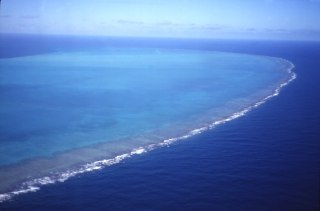
Coming in low over the reef at Kure, the northernmost coral atoll in
the world. This reef is 19 miles in circumference.
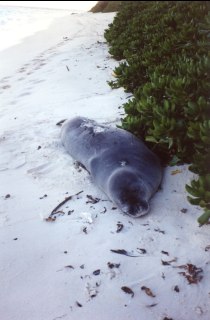
Kure Atoll is the breeding home of the Hawaiian Monk Seal, shown here
relaxing on a beach at Green Island on Kure. I don't know what damaged
his back, but he seemed to be recouperating and didn't take notice of
me!
Questions
or comments on this page?
E-mail Dr. J David Rogers at rogersda@mst.edu.

|